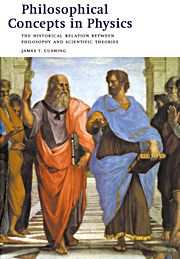 Philosophical Concepts in Physics
Philosophical Concepts in Physics Book contents
- Frontmatter
- Contents
- Preface
- Copyright acknowledgments
- PART I The scientific enterprise
- PART II Ancient and modern models of the universe
- 4 Observational astronomy and the Ptolemaic model
- 5 The Copernican model and Kepler's laws
- 6 Galileo on motion
- PART III The Newtonian universe
- PART IV A perspective
- PART V Mechanical versus electrodynamical world views
- PART VI The theory of relativity
- PART VII The quantum world and the completeness of quantum mechanics
- PART VIII Some philosophical lessons from quantum mechanics
- PART IX A retrospective
- Notes
- General references
- Bibliography
- Author index
- Subject index
4 - Observational astronomy and the Ptolemaic model
Published online by Cambridge University Press: 05 June 2012
- Frontmatter
- Contents
- Preface
- Copyright acknowledgments
- PART I The scientific enterprise
- PART II Ancient and modern models of the universe
- 4 Observational astronomy and the Ptolemaic model
- 5 The Copernican model and Kepler's laws
- 6 Galileo on motion
- PART III The Newtonian universe
- PART IV A perspective
- PART V Mechanical versus electrodynamical world views
- PART VI The theory of relativity
- PART VII The quantum world and the completeness of quantum mechanics
- PART VIII Some philosophical lessons from quantum mechanics
- PART IX A retrospective
- Notes
- General references
- Bibliography
- Author index
- Subject index
Summary
A central assumption of this book is that general philosophical discussions about science should be based upon specifics from the actual history of science. Therefore, we begin by considering the model of the universe accepted by the ancients and then we analyze some of the philosophical implications of this episode. In this chapter we present a summary of the naked-eye observations available to the ancients and outline the model of the universe that they built using this data. The next chapter then gives a description of the present-day theory that overthrew it. In Chapter 12 we discuss in more depth the profound shift in philosophical perspective necessitated by this change, as well as the contributions of several of the major precursors and shapers of that revolution.
ELEMENTARY OBSERVATIONS
In order to get into the proper frame of mind to appreciate a discussion of an ancient model of the universe in which the earth was pictured as being at rest, the modern reader who ‘knows’ that the earth moves around the sun and also spins on its axis might ask the following question. How would you demonstrate that the earth makes an orbit about the sun and that it turns on its own axis? Just use naked-eye observations – no photographs from satellites allowed. You will find that this is not such a simple exercise. Perhaps then the view the ancients had of their universe will seem less bizarre to you.
Information
- Type
- Chapter
- Information
- Philosophical Concepts in PhysicsThe Historical Relation between Philosophy and Scientific Theories, pp. 43 - 58Publisher: Cambridge University PressPrint publication year: 1998